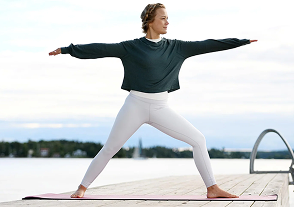Osteoporosis - "porous bone" - is one of the most widespread diseases according to the World Health Organization (WHO). In Germany, one in four women and over 6.3 million women and men suffer from it. Around 885,000 new cases are diagnosed every year. Osteoporosis is the name given to a systemic metabolic disease of the bony skeleton. The bone density and thus the strength of the bones gradually decreases (reduction in bone density = osteopenia). If the density falls below a certain value, osteoporosis is present.
Osteoporosis is primarily a disease of old age. Women are affected more frequently and earlier than men. However, not everyone shares this fate. Even if osteoporosis cannot be cured, it can be treated well. The prerequisite is a diagnosis as early as possible in order to start various therapeutic measures. Lifestyle plays a key role in prevention from an early age.
What exactly is osteoporosis?
The metabolism of the bones is very complex and is characterized by a balance of constant breakdown and reconstruction. Bone density, and therefore the strength of the skeleton, reaches its peak at around 30 years of age. With increasing age, bone density decreases continuously. If bone metabolism is not optimal, more bone mass is lost than built up. The microarchitecture of the bone interior is a three-dimensional framework of fine bone beads with small cavities in between, similar to the structure of a (rigid) sponge. If the bone beads recede due to osteopenia, the cavities become larger. As a result, the bone becomes porous, it loses its stability, it deforms and it becomes more susceptible to fractures.
Around 95% of patients suffer from primary osteoporosis. Women after the menopause (postmenopausal osteoporosis due to oestrogen deficiency) and people over the age of 70 (senile osteoporosis) in particular have an increased risk of developing the disease. Other risk factors favor the development of osteoporosis. These are a familial (genetic) predisposition, lack of exercise, "dietary sins" with phosphate-rich and calcium-poor food (soft drinks, fast food), vitamin D deficiency and heavy consumption of alcohol, coffee or cigarettes.
In rare cases, patients with pre-existing or concomitant diseases (e.g. cancer, diabetes mellitus, hormonal imbalances, side effects of medication or medication abuse) can develop so-called secondary osteoporosis.
How can osteoporosis be prevented?
The aim of prevention is to maintain or improve the structures of the bone interior and the stability of the bones for as long as possible. Preventive measures relate to various areas of lifestyle:
- An important building block is a a healthy, balanced diet. Even in childhood, a diet rich in calcium, protein, minerals and vitamins can lay the foundation for a strong bone structure. In adults, an optimized, balanced diet slows down bone loss. Calcium and vitamin D in particular play a key role in preventing osteoporosis. From time to time it is necessary to include nutritional supplements in the diet. After consultation with the doctor treating you, temporary deficiencies can be compensated for in this way.
- Regular exercise is crucial for bone health. Weight-bearing physical activities in particular promote bone formation. It is important to choose an activity with a low risk of injury. Advice from your doctor or a physiotherapist can contribute to a balanced exercise or movement plan.
- Specials Balance and coordination training for general fall prevention improves balance, responsiveness and therefore gait safety.
- Reduction or also abstaining from stimulantsespecially alcohol and nicotine. Both substances promote the reduction of bone density.
How does osteoporosis manifest itself?
Osteoporosis is initially completely asymptomatic and therefore goes unnoticed for a long time. The first signs only appear as the disease progresses. In the early stages, patients describe a "general feeling of weakness in the back" and diffuse pain in the back or large joints (hips, knees). As the disease progresses and without treatment, the pain in the spine or sternum becomes more severe. The height of the body can decrease due to slow, painless "creeping fractures" (hunchback, "widow's hump") and spontaneous bone fractures can occur without any recognizable cause or after minor strain (e.g. violent sneezing, lifting a heavy object, harmless fall). This often results in fractures of the upper or lower arm, vertebral body fractures and fractures near the hip such as femoral neck fractures.
How is osteoporosis diagnosed?
It is crucial to diagnose osteoporosis as early as possible in order to reduce the symptoms and effects through targeted therapies. Women and men over the age of 70, if there are other risk factors and when the first symptoms occur, should consult an osteoporosis specialist (osteologist). The medical history, blood tests and a physical examination provide initial indications of possible osteoporosis. A bone density measurement (osteodensitometry) is then carried out to confirm the diagnosis and assess the risk.
Osteoporosis - and now?
Depending on how advanced the disease is, there are various therapeutic options. Osteoporosis therapy consists of different components and requires the cooperation of several specialist areas. The individual pillars of therapy are
- The Drug treatment includes replacement therapies for oestrogen, calcium or vitamin D deficiency. Furthermore, certain medications can slow down bone loss, while others stimulate bone formation. Painkillers can also be used to relieve symptoms.
- A balanced, bone-healthy diet with a conscious selection of foods that support bone metabolism and promote bone formation. Relevant websites or nutritionists are good sources of advice and information for this.
- Most accidents happen at home. Osteoporosis patients break bones easily, so the fall prevention should be given special attention. This includes, for example
- Tripping hazards such as slippery carpets, loose extension cords or "clutter" lying around should be removed.
- Wearing non-slip, flat shoes.
- Adequate lighting in the home. Wear and, if necessary, check visual aids.
- Be aware of the effects of medication on gait safety (e.g. sleeping pills, tranquillizers, anti-depressants).
- The most important point in the prevention and treatment of osteoporosis is sufficient, varied exercise. physical activity. Numerous studies have shown that resting for fear of overexertion or injury not only causes muscles to shrink, but also leads to a reduction in bone mass. It is not important whether this activity is demanding physical work or sport. Training science and study results show that exercise should be dynamic, varied, frequent and intense in order to achieve a high level of muscle and bone development. Simply "more exercise" is probably not enough to help osteoporosis.
When selecting suitable sports, different types of training should be combined and varied. The focus here should be on enjoying exercise. Sports such as hiking, Nordic walking, dancing, gymnastics or strength training strengthen the muscles of the entire body and improve endurance. Whether alone or in a group, in a club or "just because" - the pleasure of exercise should not be neglected. The amount of activity depends on how you feel and your physical capabilities. Even moderate but regular and long-term strength-endurance combination training increases general performance and improves bone metabolism. This improves the cardiovascular system, muscle strength, endurance, coordination, flexibility, balance and, last but not least, bone formation. This means that previously untrained people can achieve significant positive effects with little effort and minimal strain.
Especially when it comes to osteoporosis, the realization that "movement is life" is essential and leads to an improved quality of life.






